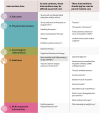The World Health Organization guideline for non-surgical management of chronic primary low back pain in adults: implications for equitable care and strengthening health systems globally
- PMID: 40624581
- PMCID: PMC12232859
- DOI: 10.1186/s41256-025-00426-w
The World Health Organization guideline for non-surgical management of chronic primary low back pain in adults: implications for equitable care and strengthening health systems globally
Abstract
The World Health Organization (WHO) released its first guideline on non-surgical management of chronic primary low back pain (LBP) in adults in 2023. The Guideline signals a timely and important global response to the current and projected burden attributable to LBP, particularly amongst populations made vulnerable, e.g. older people and people in low- and middle-income countries. The Guideline offers recommendations on which interventions for chronic primary LBP should be offered in most contexts, and those interventions that should not be offered as part of routine care. As a WHO technical product, the Guideline can function as a catalyst to commence reorientation of health systems and service delivery towards holistic, integrated, person-centred and high-value LBP care. However, to achieve this vision and Universal Health Coverage that is inclusive of LBP care, transformations are required at point of care (micro-level), within service models and organisations (meso-level) and across health system Building Blocks (macro-level). In this paper, we consider implications of the Guideline for health services and health systems globally. We highlight opportunities and priorities to build capacity across the Building Blocks of health systems and how current global health agendas, such as the WHO 14th General Program of Work, UN Decade of Healthy Ageing 2021-2030, and Rehabilitation 2030 can support implementation of the Guideline's recommendations. Global collaborative and multi-sectoral efforts, supported by countries, health workers, professional/academic societies, health financing agencies, civil society organisations, private sectors, and people with lived experience will be needed to sustainably implement the Guideline's recommendations into health systems globally.
Keywords: Chronic pain; Health policy; Health systems; Musculoskeletal; Universal Health Coverage.
© 2025. The Author(s).
Conflict of interest statement
Declarations. Ethics approval and consent to participate: Not applicable. Consent for publication: Not applicable. Availability of data and materials: Not applicable. Competing interests: AMB was a consultant to the World Health Organization (2017–2024) and was responsible for leading the development of the Guideline. AMB declares research grant income, unrelated to the current submission, paid to his institution in the 36 months prior to submission of the current paper, from the following agencies: AO Alliance, Asia Pacific League of Associations for Rheumatology, Australian Rheumatology Association, Pan American League of Associations for Rheumatology, World Federation of Chiropractic, Australian Government Department of Health, Medical Research Future Fund (Australian National Health and Medical Research Council), Western Australian Government Department of Health Grant, Bone and Joint Decade Foundation, Institute for Bone and Joint Research, Canadian Memorial Chiropractic College, and Arthritis and Osteoporosis Western Australia. AMB also declares consulting fees paid by the World Health Organization, an honorarium paid by the American College of Rheumatology, and travel support to attend technical and scientific meetings from World Health Organization, the University of Otago, and World Federation of Chiropractic. AMB is an unpaid and voluntary member of the International Coordinating Council of the Global Alliance for Musculoskeletal Health. YS was the responsible technical officer for the Guideline development. AB was the responsible Director of the WHO Department of Maternal, Newborn, Child and Adolescent Health and Ageing. The authors alone are responsible for the views expressed in this article and they do not necessarily represent the views, decisions or policies of the institutions with which they are affiliated. AI and AI-assisted technologies: No AI was used in the preparation of this manuscript. Role of medical writer or editor: Not applicable.
Figures


Similar articles
-
Clinical guidelines and payer policies on fusion for the treatment of chronic low back pain.Spine (Phila Pa 1976). 2011 Oct 1;36(21 Suppl):S144-63. doi: 10.1097/BRS.0b013e31822ef5b4. Spine (Phila Pa 1976). 2011. PMID: 21952186
-
How to Implement Digital Clinical Consultations in UK Maternity Care: the ARM@DA Realist Review.Health Soc Care Deliv Res. 2025 May;13(22):1-77. doi: 10.3310/WQFV7425. Health Soc Care Deliv Res. 2025. PMID: 40417997 Review.
-
Incorporating considerations of cost-effectiveness, affordability, and resource implications in guideline development: article 6 in Integrating and coordinating efforts in COPD guideline development. An official ATS/ERS workshop report.Proc Am Thorac Soc. 2012 Dec;9(5):251-5. doi: 10.1513/pats.201208-059ST. Proc Am Thorac Soc. 2012. PMID: 23256167
-
The Lived Experience of Autistic Adults in Employment: A Systematic Search and Synthesis.Autism Adulthood. 2024 Dec 2;6(4):495-509. doi: 10.1089/aut.2022.0114. eCollection 2024 Dec. Autism Adulthood. 2024. PMID: 40018061 Review.
-
Addressing Inequalities in Long Covid Healthcare: A Mixed-Methods Study on Building Inclusive Services.Health Expect. 2025 Aug;28(4):e70336. doi: 10.1111/hex.70336. Health Expect. 2025. PMID: 40600494 Free PMC article.
References
-
- World Health Organization. WHO guideline for non-surgical management of chronic primary low back pain in adults in primary and community care settings. Geneva: WHO; 2023 (https://www.who.int/publications/i/item/9789240081789. - PubMed
-
- Maher C, Underwood M, Buchbinder R. Non-specific low back pain. Lancet. 2017;389:736–47. 10.1016/S0140-6736(16)30970-9. - PubMed
-
- World Health Organization. Technical Brief. Primary health care. An integrated approach for delivering universal health coverage with a focus on social justice, equity, and solidarity. Geneva: World Health Organization; 2022 (https://www.who.int/publications/m/item/primary-health-care.-an-integrat....
-
- Bunzli S, Watkins R, Smith A, Schütze R, O’Sullivan P. Lives on hold: a qualitative synthesis exploring the experience of chronic low-back pain. Clin J Pain. 2013;29:907–16. 10.1097/AJP.0b013e31827a6dd8. - PubMed
MeSH terms
LinkOut - more resources
Full Text Sources
Medical
Research Materials
Miscellaneous

